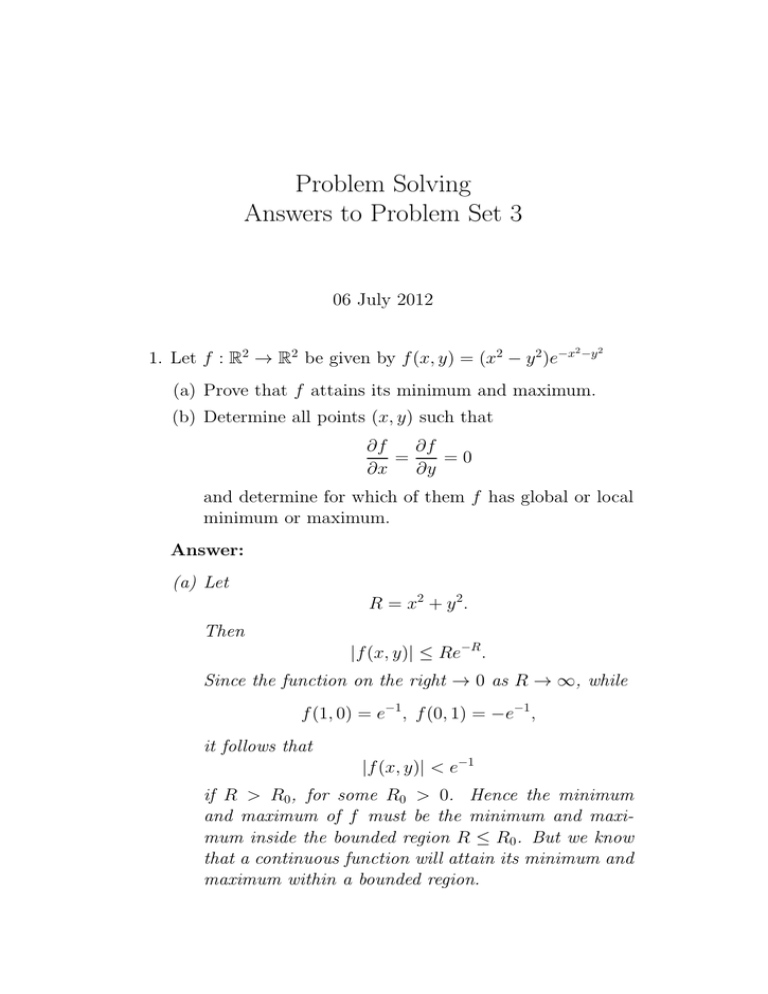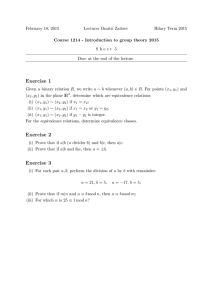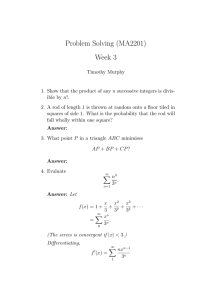Problem Solving Answers to Problem Set 3
advertisement

Problem Solving Answers to Problem Set 3 06 July 2012 1. Let f : R2 → R2 be given by f (x, y) = (x2 − y 2 )e−x 2 −y 2 (a) Prove that f attains its minimum and maximum. (b) Determine all points (x, y) such that ∂f ∂f = =0 ∂x ∂y and determine for which of them f has global or local minimum or maximum. Answer: (a) Let R = x2 + y 2 . Then |f (x, y)| ≤ Re−R . Since the function on the right → 0 as R → ∞, while f (1, 0) = e−1 , f (0, 1) = −e−1 , it follows that |f (x, y)| < e−1 if R > R0 , for some R0 > 0. Hence the minimum and maximum of f must be the minimum and maximum inside the bounded region R ≤ R0 . But we know that a continuous function will attain its minimum and maximum within a bounded region. (b) Since f (y, x) = −f (x, y), it is sufficient to find stationary points when x ≥ y. If x = y then f (x, y) = 0. Differentiating at (x, x) with respect to x, ∂f 2 = 2xe−2x . ∂x Similarly ∂f 2 = −2xe−2x . ∂y Thus the only stationary point on the line x = y occurs at (0, 0). Since f (, 0) > 0, f (0, ) < 0 for small , it follows that (0, 0) is not a local minimum or maximum. Now let us assume x > y. Taking logarithms, log f = log(x2 − y 2 ) − x2 − y 2 . Thus while ∂f /∂x 2x − 2x, = 2 f x − y2 ∂f /∂y 2y − 2y, =− 2 f x − y2 We are assuming that (x, y) 6= (0, 0). If x = 0 but y 6= 0 then y 2 = 1. Hence y = −1 since we are assuming that x > y. Similarly, if y = 0 but x 6= 0 then x2 = 1, ie x = 1. If x 6= 0 and y 6= 0 then x2 − y 2 = 1 and x2 − y 2 = −1, which is impossible. Thus the stationary points are: (0, 0), (0, ±1), (±1, 0). Since f (0, ±1) = −e−1 , and the global minimum is attained, these must be global minima. Similarly, since f (±1, 0) = e−1 , these must be global maxima. 2. A sequence u(n) satisfies the relation u(n + 2) = [u(n + 1)]2 − u(n), with u(1) = 13 and u(2) = 45. Prove that 2012 divides infinitely many terms of the sequence. Answer: It is sufficient to consider the sequence mod 2012. Note that we can continue the sequence backwards as well as forwards. In particular we can go back to u(0), with u(0) = 452 − 13 = 2025 − 13 = 2012. Now consider consecutive pairs (u(n), u(n + 1)) mod 2012. Since there are only a finite number of pairs modulo 2012, there must be a repeat. Let the first repeat be u(n + r) ≡ u(n), u(n + r + 1) ≡ u(n + 1) (mod 2012) From the recurrence relation, if n > 0. u(n + r − 1) ≡ u(n − 1) (mod 2012) taking the repetition one step earlier. Hence the first repetition comes at the beginning, u(r) ≡ u(0), u(r + 1) ≡ u(1) (mod 2012) But then it follows that the sequence must recur every r steps, and in particular 0 ≡ u(0) ≡ u(r) ≡ u(2r) ≡ u(3r) ≡ · · · (mod 2012).







